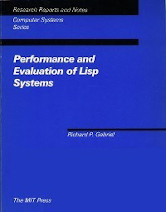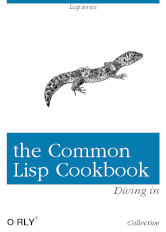Last Updated on January 21, 2024
4. Patterns of Software: Tales from the Software Community by Richard P. Gabriel
 Performance and Evaluation of Lisp Systems focuses on what determines the performance of a Lisp implementation and how to measure it.
Performance and Evaluation of Lisp Systems focuses on what determines the performance of a Lisp implementation and how to measure it.
It is the source of the so-called “Gabriel Benchmarks”, which are still in use to benchmark Unix systems.
Chapters cover:
- Introduction
- The Implementation:
- MacLisp – one of the first Lisps written on the PDP-10.
- MIT CADR – The CADR is the MIT Lisp machine; it is quite similar to the Symbolics LM-2. Both machines run a dialect of Lisp called ZetaLisp, which is a direct outgrowth of the MIT Lisp Machine Lisp.
- Symbolics – an intellectual descendant of the CADR and the LM-2 but has more hardware support for Lisp.
- LMI Lambda – the Lambda is a 32-bit microprogrammed processor with up to 64K 64-bit words of virtual control store and a 200 nanosecond microcycle time.
- S-1 Lisp – runs on the S-1 Mark IIA computer, which is a supercomputer-class complex instruction set computer. S-1 Lisp is almost entirely written in Lisp.
- Franz Lisp – written at the University of California at Berkeley by Richard Fateman and his students. It was originally intended to be a Lisp that was suitable for running a version of MACSYMA on a Vax.
- NIL – New Implementation of Lisp, one of the main influences on the design of Common Lisp.
- Spice Lisp – an implementation of Common Lisp written mostly in Common Lisp and partly in microcode.
- Vax Common Lisp – the first Common Lisp implemented on stock hardware.
- Portable Standard Lisp – a ‘LISP in LISP’ that has been in development at the University of Utah since 1980 and at Hewlitt-Packard since 1982.
- Xerox D-Machine.
- The Benchmarks:
- Tak – a variant of the Takeuchi function that Ikuo Takeuchi of Japan used as a simple benchmark.
- Stak – a variant of TAK; it uses special binding to pass arguments rather than the normal argument-passing mechanism.
- Ctak – a variant of TAK that uses CATCH and THROW to return values rather than the function-return mechanism.
- Takl – very much like TAK, but it does not perform any explicit arithmetic.
- Takr – a function that was defined to thwart the effectiveness of cache memories. TAKR comprises 100 copies of TAK, each with a different name.
- Boyer – a rewrite-rule based simplifier combined with a very dumb tautology-checker, which has a three-place IF as the basic logical connective.
- Browse – it is essentially a theorem-proving benchmark.
- Destructive – benchmarks the ‘destructive’ (hence the name) list utilities. It does this by constructing a tree that is a list of lists and then destructively modifying its elements. This manipulation proceeds by means of a fairly elaborate iterative control structure.
- Traverse – tries to measure the performance that can be expected from the abstract data structure systems provided by the various Lisp dialects.
- Derivative – performs a simple symbolic derivative in which the data representation is the usual S-expression representation for functions.
- Data-Driven Derivative – exactly like DERIV except that functions taking derivatives of specific operators are located on the property list of the operator rather than buried in a piece of code.
- Another Data-Driven Derivative – a variant of DDERIV. It optimizes FUNCALL by using a FUNCALL-like function that assumes it is being handed compiled code.
- Division by 2 – this benchmark that divides by 2 using lists of n NIL’s.
- FFT – a FFT benchmark tests a variety of floating point operations including array references.
- Puzzle – solves a search problem that is a block-packing puzzle invented by John Conway.
- Triangle – similar in many respects to the Puzzle benchmark, but it does not use any two-dimensional arrays. Therefore it provides a differentiator between one-dimensional and two-dimensional array references.
- File Print – measures the performance of file output. The program checks to see whether there is a file with a certain name (there should not be). Then it creates and opens a new file with that name, prints a test pattern into that file, and then closes it.
- File Read – tests file input. It reads the file produced by FPRINT.
- Terminal Print – tests terminal output.
- Polynomial Manipulation – computes powers of particular polynomials.
- Conclusions.
The book is available under a Creative Commons License.
5. Loving Common Lisp, or the Savvy Programmer’s Secret Weapon by Mark Watson
 The purpose of this book is to provide a quick introduction to Common Lisp and then provide the user with many fun and useful examples for using Common Lisp.
The purpose of this book is to provide a quick introduction to Common Lisp and then provide the user with many fun and useful examples for using Common Lisp.
This book may be shared using the Creative Commons “share and share alike, no modifications, no commercial reuse” license.
6. The Common Lisp Cookbook by The Common Lisp Cookbook Project
 The Common Lisp Cookbook is a thorough collection of problems, solutions, and practical examples for anyone programming in Common Lisp, built by a collaborative project. The purpose is to provide readers with quick and easy-to-find references for day-to-day programming in Common Lisp.
The Common Lisp Cookbook is a thorough collection of problems, solutions, and practical examples for anyone programming in Common Lisp, built by a collaborative project. The purpose is to provide readers with quick and easy-to-find references for day-to-day programming in Common Lisp.
This is a collaborative project that aims to provide for Common Lisp something similar to the Perl Cookbook published by O’Reilly
Next page: Page 3 – Casting SPELs in Lisp and more books
Pages in this article:
Page 1 – Common Lisp: A Gentle Introduction to Symbolic Computation
Page 2 – Patterns of Software: Tales from the Software Community and more books
Page 3 – Casting SPELs in Lisp and more books
Page 4 – Paradigms of Artificial Intelligence Programming and more books
Page 5 – Interpreting LISP and more books
Page 6 – The Evolution of Lisp
All books in this series:
| Free Programming Books | |
|---|---|
| Ada | ALGOL-like programming language, extended from Pascal and other languages |
| Agda | Dependently typed functional language based on intuitionistic Type Theory |
| Arduino | Inexpensive, flexible, open source microcontroller platform |
| Assembly | As close to writing machine code without writing in pure hexadecimal |
| Awk | Versatile language designed for pattern scanning and processing language |
| Bash | Shell and command language; popular both as a shell and a scripting language |
| BASIC | Beginner’s All-purpose Symbolic Instruction Code |
| C | General-purpose, procedural, portable, high-level language |
| C++ | General-purpose, portable, free-form, multi-paradigm language |
| C# | Combines the power and flexibility of C++ with the simplicity of Visual Basic |
| Clojure | Dialect of the Lisp programming language |
| ClojureScript | Compiler for Clojure that targets JavaScript |
| COBOL | Common Business-Oriented Language |
| CoffeeScript | Transcompiles into JavaScript inspired by Ruby, Python and Haskell |
| Coq | Dependently typed language similar to Agda, Idris, F* and others |
| Crystal | General-purpose, concurrent, multi-paradigm, object-oriented language |
| CSS | CSS (Cascading Style Sheets) specifies a web page’s appearance |
| D | General-purpose systems programming language with a C-like syntax |
| Dart | Client-optimized language for fast apps on multiple platforms |
| Dylan | Multi-paradigm language supporting functional and object-oriented coding |
| ECMAScript | Best known as the language embedded in web browsers |
| Eiffel | Object-oriented language designed by Bertrand Meyer |
| Elixir | Relatively new functional language running on the Erlang virtual machine |
| Erlang | General-purpose, concurrent, declarative, functional language |
| F# | Uses functional, imperative, and object-oriented programming methods |
| Factor | Dynamic stack-based programming language |
| Forth | Imperative stack-based programming language |
| Fortran | The first high-level language, using the first compiler |
| Go | Compiled, statically typed programming language |
| Groovy | Powerful, optionally typed and dynamic language |
| Haskell | Standardized, general-purpose, polymorphically, statically typed language |
| HTML | HyperText Markup Language |
| Icon | Wide variety of features for processing and presenting symbolic data |
| J | Array programming language based primarily on APL |
| Java | General-purpose, concurrent, class-based, object-oriented, high-level language |
| JavaScript | Interpreted, prototype-based, scripting language |
| Julia | High-level, high-performance language for technical computing |
| Kotlin | More modern version of Java |
| LabVIEW | Designed to enable domain experts to build power systems quickly |
| LaTeX | Professional document preparation system and document markup language |
| Lisp | Unique features - excellent to study programming constructs |
| Logo | Dialect of Lisp that features interactivity, modularity, extensibility |
| Lua | Designed as an embeddable scripting language |
| Markdown | Plain text formatting syntax designed to be easy-to-read and easy-to-write |
| Objective-C | Object-oriented language that adds Smalltalk-style messaging to C |
| OCaml | The main implementation of the Caml language |
| Pascal | Imperative and procedural language designed in the late 1960s |
| Perl | High-level, general-purpose, interpreted, scripting, dynamic language |
| PHP | PHP has been at the helm of the web for many years |
| PostScript | Interpreted, stack-based and Turing complete language |
| Prolog | A general purpose, declarative, logic programming language |
| PureScript | Small strongly, statically typed language compiling to JavaScript |
| Python | General-purpose, structured, powerful language |
| QML | Hierarchical declarative language for user interface layout - JSON-like syntax |
| R | De facto standard among statisticians and data analysts |
| Racket | General-purpose, object-oriented, multi-paradigm, functional language |
| Raku | Member of the Perl family of programming languages |
| Ruby | General purpose, scripting, structured, flexible, fully object-oriented language |
| Rust | Ideal for systems, embedded, and other performance critical code |
| Scala | Modern, object-functional, multi-paradigm, Java-based language |
| Scheme | A general-purpose, functional language descended from Lisp and Algol |
| Scratch | Visual programming language designed for 8-16 year-old children |
| SQL | Access and manipulate data held in a relational database management system |
| Standard ML | General-purpose functional language characterized as "Lisp with types" |
| Swift | Powerful and intuitive general-purpose programming language |
| Tcl | Dynamic language based on concepts of Lisp, C, and Unix shells |
| TeX | Markup and programming language - create professional quality typeset text |
| TypeScript | Strict syntactical superset of JavaScript adding optional static typing |
| Vala | Object-oriented language, syntactically similar to C# |
| VHDL | Hardware description language used in electronic design automation |
| VimL | Powerful scripting language of the Vim editor |
| XML | Rules for defining semantic tags describing structure ad meaning |
